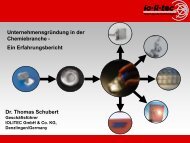Education in Chemical Entrepreneurship - KIT - Technology ...
Education in Chemical Entrepreneurship - KIT - Technology ...
Education in Chemical Entrepreneurship - KIT - Technology ...
Create successful ePaper yourself
Turn your PDF publications into a flip-book with our unique Google optimized e-Paper software.
Hauthal 2005; St<strong>in</strong>son 1999; Zbikowski 2006a, Zbikowski 2006b). And <strong>in</strong> particular,<br />
<strong>in</strong> 2007 the GDCh Special Interest Group “Association for Chemistry & Industry”<br />
(”Vere<strong>in</strong>igung für Chemie & Wirtschaft”) organized idea contests for young<br />
university chemists and provided related knowledge whether and how they can<br />
transform an idea <strong>in</strong>to a bus<strong>in</strong>ess plan and a startup.<br />
F<strong>in</strong>ally, with regard to chemistry and “academic entrepreneurship” and “Research-<br />
Based Startups” (RBSUs), a study of the Royal Society of Chemistry (RSC) on<br />
RBSUs from twenty-n<strong>in</strong>e universities <strong>in</strong> the UK revealed (Moustras 2003), for<br />
<strong>in</strong>stance, that<br />
� Chemistry as a university discipl<strong>in</strong>e appears as productive as any other<br />
discipl<strong>in</strong>e<br />
� 48% of chemistry sp<strong>in</strong> offs are jo<strong>in</strong>t with other discipl<strong>in</strong>es (“multidiscipl<strong>in</strong>arity”<br />
<strong>in</strong>clud<strong>in</strong>g bio-scientists – 69%, eng<strong>in</strong>eers – 38% and materials<br />
and IT specialists – 15%)<br />
� Two key factors <strong>in</strong>hibit<strong>in</strong>g academics from sp<strong>in</strong>n<strong>in</strong>g out companies are 1)<br />
pressure of their day job and 2) <strong>in</strong>experience.<br />
2. <strong>Technology</strong> and <strong>Chemical</strong> <strong>Entrepreneurship</strong><br />
Specifics<br />
<strong>Entrepreneurship</strong> can take the perspective that it is related to technical and nontechnical<br />
(behavioral or organizational) <strong>in</strong>novation, shows up outside and <strong>in</strong>side<br />
established organizations (“<strong>in</strong>trapreneurship”) and covers bus<strong>in</strong>ess and non-bus<strong>in</strong>ess<br />
activities. In particular, we see it as a comb<strong>in</strong>ation of human, technological, venture<br />
and environmental conditions.<br />
For educational purposes we use a theoretical framework and regard entrepreneurship<br />
fundamentally as a process of creat<strong>in</strong>g socio-economic value <strong>in</strong> the context of<br />
<strong>in</strong>terrelated systems, referr<strong>in</strong>g essentially to the def<strong>in</strong>ed sub-processes depicted <strong>in</strong><br />
Dorf and Byers (2007: 28) and Morris, Kuratko and Cov<strong>in</strong> (2008: 104). In particular,<br />
the process driven approach is adopted to identify possible <strong>in</strong>puts which are likely to<br />
be required to produce the elements of a bus<strong>in</strong>ess plan. Furthermore, a systems<br />
approach is generally emphasiz<strong>in</strong>g the cont<strong>in</strong>uous changes of the <strong>in</strong>volved systems<br />
which <strong>in</strong>itiate or require, respectively, permanent adaptations of sub-systems <strong>in</strong> l<strong>in</strong>e<br />
with conditions and forces exerted by the super-ord<strong>in</strong>ate system(s). Hence, for<br />
entrepreneurship we look at traits, attitudes, behavior, decisions and actions of<br />
<strong>in</strong>dividuals with certa<strong>in</strong> theoretical and/or practical knowledge <strong>in</strong> a scientific and/or<br />
technological doma<strong>in</strong> under situational constra<strong>in</strong>ts or drivers, respectively. And as a<br />
consequence, entrepreneurship and <strong>in</strong>novation is <strong>in</strong>tr<strong>in</strong>sically bound to “<strong>in</strong>telligence”<br />
– knowledge and foreknowledge of the world around us as the basis for decisions and<br />
actions (Runge 2006: 520). Hence, characteristics of the <strong>in</strong>dividual(s), the bus<strong>in</strong>ess<br />
idea/opportunity and the environment <strong>in</strong>teract with the types of entrepreneurial subprocesses<br />
and <strong>in</strong>fluence executions and outcomes of the sub-processes and f<strong>in</strong>ally the<br />
overall process.<br />
Figure 1 exhibits situational <strong>in</strong>fluences by an “onion-like” model of entrepreneurship<br />
as a generic “core” of features and sub-processes embedded <strong>in</strong>to (and across) shells of<br />
super-ord<strong>in</strong>ate systems which may exert essential <strong>in</strong>fluences onto the core, for<br />
<strong>in</strong>stance, on attitudes, decision-mak<strong>in</strong>g and actions. And entrepreneurship occurs as a<br />
function of the <strong>in</strong>teractions among a number of key endogenous variables and<br />
exogenous parameters (Runge 2006: 9). In this way, entrepreneurship of <strong>in</strong>dividuals<br />
Runge and Bräse - 3 -














